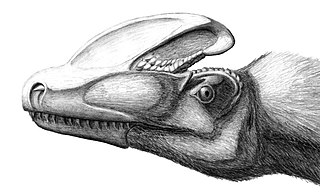 W
WDinosaurs evolved partway through the Triassic period of the Mesozoic era, around 230 Ma. At that time, the earth had one supercontinental landmass, called Pangaea, of which Europe was a part. So it remained throughout the Triassic. By the start of the Jurassic period, some 30 million years later, the supercontinent began to split into Laurasia and Gondwana. The largest inlet from Panthalassa, the superocean that surrounded Pangaea, was called the Tethys Ocean, and as this inlet cut deeper into the supercontinent, much of Europe was flooded.
 W
WBurianosaurus is a genus of ornithopod dinosaur that lived in what is now the Czech Republic, being the first validly named dinosaur from that country. The type species, B. augustai, was named in 2017; the genus name honours the Czech palaeoartist Zdeněk Burian, and the species name honours the Czech palaeontologist Josef Augusta. The holotype specimen is a femur discovered in sediments belonging to the Peruc-Korycany Formation in 2003, which was described as possibly belonging to an iguanodont in 2005.
 W
WThe Fort of Paimogo, also known as the Fort of Our Lady of the Angels of Paimogo, stands in a dominant position on Paimogo beach near the town of Lourinhã, Lisbon District in Portugal Constructed in 1674, it ceased to serve a military function in 1834 and is now under threat from coastal erosion. The fort presents an almost unique example of a fort from that period that has not undergone subsequent modification.
 W
WLaurasiformes is an extinct clade of sauropod dinosaurs from the late Early Cretaceous of Europe, North and South America. It was defined in 2009 by the Spanish paleontologist Rafael Royo-Torres as a clade containing sauropods more closely related to Tastavinsaurus than to Saltasaurus. Genera purported to form part of this clade include Aragosaurus, Galvesaurus, Phuwiangosaurus, Venenosaurus, Cedarosaurus, Tehuelchesaurus, Sonorasaurus and Tastavinsaurus.
 W
WProceratosauridae is a family or clade of theropod dinosaurs from the Middle Jurassic to the Early Cretaceous.
 W
WThe dinosaurs of Romania are exclusively Cretaceous. Lowermost Cretaceous dinosaurs come from a bauxite mine in the Bihor County that has yielded thousands of disarticulated bones. Uppermost Cretaceous dinosaurs have been known from the Hațeg Basin since the end of the 19th century, mostly as bone concentrations ; more recently, nests with dinosaur eggs, including hatchlings, have been found in Hațeg. Although separated by a gap of approximately 60 million years, the two dinosaur faunas from Romania share some common features: predominance of ornithopods, absence of large theropods, and, in general, the small size of the individuals.
 W
WStegosaurus, from Greek stegos (στέγος), which means roof, and sauros (σαῦρος), which means lizard, is a genus of herbivorous thyreophoran dinosaur. Fossils of this genus date to the Late Jurassic period, where they are found in Kimmeridgian to early Tithonian aged strata, between 155 and 150 million years ago, in the western United States and Portugal. Of the species that have been classified in the upper Morrison Formation of the western US, only three are universally recognized; S. stenops, S. ungulatus and S. sulcatus. The remains of over 80 individual animals of this genus have been found. Stegosaurus would have lived alongside dinosaurs such as Apatosaurus, Diplodocus, Brachiosaurus, Allosaurus, and Ceratosaurus; the latter two may have preyed on it.
 W
WTuriasauria is an unranked clade of basal sauropod dinosaurs known from Middle Jurassic to Early Cretaceous deposits in Europe, North America, and Africa.